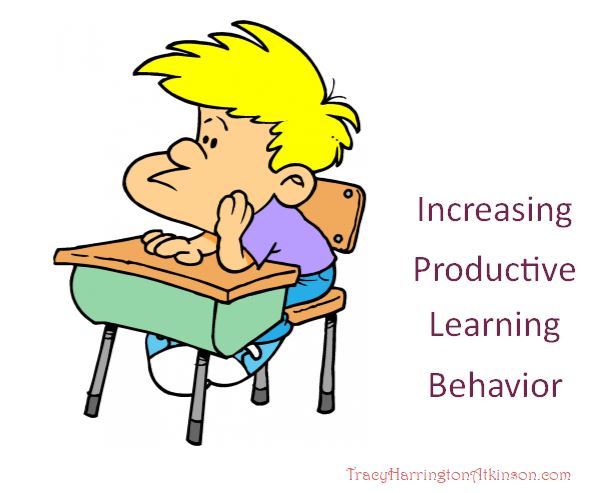Let’s look at the steps to increase productive learning behavior. 
First, accentuate the positive.
Be aware of the productive behavior. Catch the child doing something productive and reinforce it. You may use masking tape on their desk or maybe a pad of paper. Record the number of times that you praise them for a five minute interval.
What are you tracking? Maybe you’re counting how many times they stay in their seats. Possibly the number of times they raise their hands. Or whatever the positive behavior you’re looking to reinforce is. The point is to recognize the productive behavior. Especially make sure that you make more positive comments than negative.
Second, point out the productive behaviors.
- “When you’re doing a great job you watch the board.”
- “The whole time I was doing the problem, Misty paid attention.”
- “Colin, great answer.”
- “You listened very carefully to my question.”
Positive responses not only reinforce the student to whom it was directed but it also gives some cues to the rest of the class. They understand what you mean by paying attention and working hard. Young children especially pick up cues from the actions and they learn to model their actions. We want to make sure that we model them after positive examples that we’ve established and modeled. Remember public praise can be embarrassing especially if you have a highly introverted student. Make sure that you know your student well.
Third, start small.
Fourth, vary your comments.
Fifth, individual effective reinforcers
By Tracy Atkinson
 Tracy Atkinson, mother of six, lives in the Midwest with her husband and spirited long-haired miniature dachshunds. She is a teacher, having taught elementary school to higher education, holding degrees in elementary education and a master’s in higher education. Her passion is researching, studying and investigating the attributes related to self-directed learners and learning styles. She speaks at conferences on learning styles and has published several titles, including MBTI Learning Styles: A Practical Approach, The Art of Learning Journals, Calais: The Annals of the Hidden, Lemosa: The Annals of the Hidden, Book Two,Rachel’s 8, The Personal Pursuit of Perfection and Securing Your Tent. She is currently working on a non-fiction text exploring the attributes of self-directed learners: The Five Characteristics of Self-directed Learners. Check out her online courses at: Udemy.
Tracy Atkinson, mother of six, lives in the Midwest with her husband and spirited long-haired miniature dachshunds. She is a teacher, having taught elementary school to higher education, holding degrees in elementary education and a master’s in higher education. Her passion is researching, studying and investigating the attributes related to self-directed learners and learning styles. She speaks at conferences on learning styles and has published several titles, including MBTI Learning Styles: A Practical Approach, The Art of Learning Journals, Calais: The Annals of the Hidden, Lemosa: The Annals of the Hidden, Book Two,Rachel’s 8, The Personal Pursuit of Perfection and Securing Your Tent. She is currently working on a non-fiction text exploring the attributes of self-directed learners: The Five Characteristics of Self-directed Learners. Check out her online courses at: Udemy.
![]() Subscribe to our YouTube Channel by clicking here.
Subscribe to our YouTube Channel by clicking here.


Comments are closed